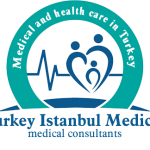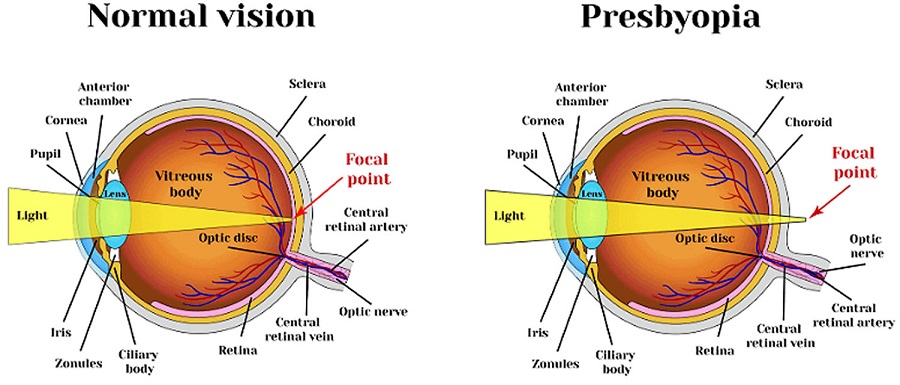What is Presbyopia (Nearsightedness)?
Presbyopia is a condition called visual impairment with age. This is related to the reduced ability of the eyes to see close objects clearly. The alignment of the lens in the eye is seen with the decline of its focusing abilities.
It occurs due to the loss of flexibility of the lens in the eye. It is also known as near vision problem. Presbyopia usually begins in the early 40s. The reason for this is that this stiffness increases with the age of 40 and loses the ability to see clearly near the eye as a natural result of aging. This process continues until the mid-60s.
At the beginning of the 60s, this process becomes stagnant. Especially after the age of 65, the eye’s ability to focus either actually stops or decreases to a minimum. After this stage, glasses are required to see up close.
Although the problem that occurs for presbyopia and hyperopia is actually the same, the cause of the problem in both is different. Both hyperopia and presbyopia are refractive problems, and the image coming from the outside falls behind the focal point of the retina.
While hyperopia is caused by the shorter than normal eyeball, presbyopia is the hardening of the lens and losing its flexibility with aging. Especially after the age of 40, people should not neglect regular eye examinations. It is important in terms of diagnosis and early treatment of age-related blindness.
Why Presbyopia (Nearsightedness) Occurs?
When a distant object comes close, the stimulus reaching the brain is evaluated and transmitted to the eye. Here, as the muscles contract and relax in the so-called “ciliary body” of the eye, the fibers connected to it are stretched or loosened. This movement of the fibers causes the lens to become thinner or thicker, increasing its refraction. The eye loses this ability depending on age.
Although it has not been conclusively proven, the closest theory regarding the age-related loss of this ability is the cell aging theory. This theory is that our eye cells lose this ability just as our hair turns white due to aging.
Therefore, this problem is not considered as a pathological problem, but as a physiological aging. Presbyopia increases in every person in a very standard way over the years. After the age of 40, it grows by +1 every 10 years. At the age of 50, it will be +2, and at the age of 60, it will be +3.
But here is an interesting situation. For example, if our eye is -2, +1 is added to it at the age of 40. In this case, you need the number -1 to see up close. When you reach the age of 50, while you need -2 for distance, there is no need for close glasses. For this reason, the reason why the patients who are nearsighted and say, ‘I can see the nears very well’, see the nears well, because the two disorders overlap and create a defect-reducing effect.
What are The Symptoms of Presbyopia (Nearsightedness)?
Presbyopia begins at age 40 and progresses at a very slow pace. The fastest progression is between the ages of 46-52. For this reason, the complaints of the patients become more evident at this age and they apply to the doctor in this period. If there is an eye disorder such as hyperopia, such as nearsightedness, the symptoms appear earlier, whereas if there is a problem of nearsightedness such as myopia, the symptoms appear at a later age.
The most common complaints are;
- Weakness of seeing close objects clearly
- Inability to see close objects, even if the head does not need to be brought close for reading or sewing
- Difficulty focusing on close objects and eyestrain
- Difficulty seeing on television or computer screens
- No need for unusual size reading materials.
- The need for a bright light during reading, such as a book or newspaper.
- The need to squint when reading or working at close range
- In case of progression of the disease, pain in the forehead and temples due to long-term inability to see clearly
- Headache
- Redness or itching of the eyes while reading or working.
What is The Difference Between Presbyopia (Nearsightedness) and Hyperopia?
Like hyperopia, myopia and astigmatism, it is a refractive and focusing problem that occurs in the eye. Hyperopia and presbyopia are confused in that the refraction problem in the eye creates a near vision defect. However, hyperopia and presbyopia refer to different conditions.
Hyperopia is not an age-related problem of nearsightedness. Hyperopia, which can occur at any age, may progress with age, but it does not occur due to age. Presbyopia is a near vision problem that occurs with the loss of some functions in the eye structure due to aging after the age of 40-45.
To Whom Can Presbyopia (Nearsightedness) Treatment Be Applied?
We can list the people and situations where presbyopia treatment can be applied as follows;
- Patients over the age of 40-45 with near vision problems
- People who have cataracts and will have FAKO surgery
- Patients who have not detected a serious problem in their eyes
- People who do not have high astigmatism
What are Presbyopia (Nearsightedness) Risk Factors?
There are some risk factors for Presbyopia (Nearsightedness).
These:
-
Age:
It is the most important risk factor. After the age of 40, almost everyone encounters the problem of presbyopia to some degree.
-
Some Diseases:
Having hyperopia in the eye, multiple sclerosis (MS disease) and cardiovascular diseases sometimes cause the problem of nearsightedness even before the age of 40.
-
Medicines:
Antidepressants, antihistamine drugs and some diuretic (diuretic) drugs can cause early presbyopia.
How is Presbyopia (Nearsightedness) Diagnosed?
For the diagnosis of presbyopia, it is important that the patient first notices the symptoms in himself or that he is noticed by the ophthalmologist as a result of regular eye examination since the age of 40. A vision test is first applied to a person who applies to an ophthalmologist or comes to regular eye examination as a result of his symptoms. During eye examination, people with the disease have difficulty seeing objects closer than 50 cm clearly.
If the disease is diagnosed, the Snellen eye test is applied in the next step. In the Snellen eye test, the patient tries to read various letters in the table from a distance. It is measured whether the person can read letters from a certain distance. As a result of this test, the patient can be diagnosed.
What is Presbyopia (Nearsightedness) Treatment?
The aim in the treatment of presbyopia is to provide an image similar to the image when the eye focuses. For this, treatment methods such as glasses, contact lenses, refractive surgery and intraocular lens placement surgery can be applied.
-
Glasses:
Glasses are the simplest and safest treatment for presbyopia.
-
Reading (Single Focal) Glasses:
If your eye does not have any other refractive errors, only reading glasses will suffice. Otherwise, you may need to use both distance and near glasses.
-
Bifocal Glasses:
In these glasses, two different focal points, near and far, are separated by a line on the glass. May cause complaints in medium distance images.
-
Trifocal Glasses:
To reduce the complaints in bifocal glasses, it has 3 focus: near, middle and far. Adjusted for close focus reading, medium focus for computer use.
-
Progressive Glasses:
In these glasses, the focal points are not separated by a line. Different regions have different focal points.
-
Office Progressive Glasses:
These glasses have focus for computer distance and close working distance.
-
Contact Lens:
People who do not want to wear glasses can use contact lenses.
-
Monovision Contact Lens:
One eye far vision is adjusted for one eye near vision. In this method, the patient’s adaptation is tried. Not every patient can get used to seeing with one eye.
-
Multifocal Contact Lens:
These lenses have different rings at different focal points. There is a slight loss of image quality. Both far and near image are equally sharp. Although this situation is not normal, our brain adapts over time and suitable patients use it comfortably.
-
Modified Monovision:
In this method, which is used in the treatment of presbyopia, the person uses bifocal or multifocal contact lenses in the dominant eye, and close-up contact lenses in the non-dominant eye.
-
Refractive Surgery
-
Laser Refractive Surgery:
In this method, laser treatment is applied to the eyes so that one eye can see far from the other eye.
So monovision is done. The patient has to get used to this situation. Before the operation, the patient’s compliance can be tried with mono vision contact lenses.
-
Corneal Inlay:
A small ring-shaped piece called an inlay is placed inside the corneal layer. Thanks to this piece, the rays passing through the cornea are refracted and nearby objects are seen more clearly.
What Can Be Done to Prevent Presbyopia (Nearsightedness) from Progressing?
- People over the age of 40 should definitely have their eyes checked by a specialist doctor.
- People between the ages of 40-55 should have their eyes checked once every 2-4 years, even if there is no disease or sign of illness, people between the ages of 55-65 should have an eye check once every 1-3 years, and people over the age of 65 should have their eyes checked once a year.
- Presbyopia is a physiological problem that is not very dangerous if proper controls are made and eye health is taken care of.
- It is seen in many people with advancing age. It can be treated easily.
- The risk of disease is the same between the person with genetic eye problems and the person who does not, if they are of the same age.
- It is of great importance not to skip routine controls for eye health, which is one of the organs most affected by the aging process.

